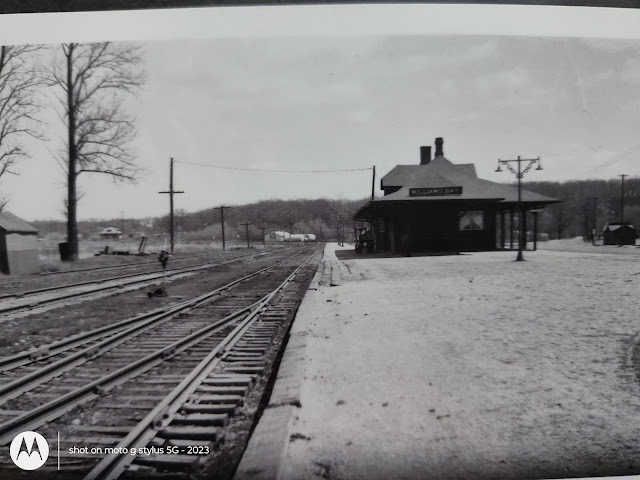The Beach House is modeled on the depot, it is not the depot. [James Cudworth comment on a post]
 |
| Street View, Sep 2021 |
 |
| Larry Foht posted Chicago North Western Railroad Depot Williams Bay Wisconsin Date: 1934 Ritzman Photo Larry Foht collection: Brian A Morgan: Williams Bay end of the Elgin Stateline Railway aka the C&NW Williams Bay Branch. On June 11, 1856, a large crowd of townspeople gathered at the first Lake Geneva train depot (historians think it was located on the south side of town most likely near the intersection of Curtis St. and town line Road) for one of the most exciting events that had ever happened in the small village. a 13-gun salute and a marching band welcomed the arrival of a Wisconsin Central train from Chicago via Elgin, six coaches carrying a total of 600 passengers. it was the first train to ever arrive in Lake Geneva. the passengers disembarked and followed the crowd to St. Francis de Sales church where a lavish picnic was served and railroad officials made speeches about the future. Unfortunately, this first attempt at establishing train service from Chicago to Lake Geneva was short-lived. An economic crash in 1857 and the political climate leading up to the Civil War halted service and prevented opportunities for new investment. It would be more than a decade before a train returned to Lake Geneva. But whether or not the spectators on that historic day in 1856 imagined it, The arrival of regular train service from Chicago would eventually transform Lake Geneva from a quaint, rural hamlet to an internationally known resort community, establishing this area’s identity in ways that still resonate today. THE CHICAGO & NORTHWESTERN RAILROAD By 1871, a small handful of moneyed Chicagoans had discovered the charms of country life around Geneva Lake, including Shelton Sturges, heir to a sizable grain elevator fortune, whose famous Lake Geneva estate Maple Lawn was built between 1870 and 1871. In a book called Steam Trains to Lake Geneva, railroad historian Paul L. Behrens suggests that Sturges may have used his influence in Chicago to encourage the Chicago & Northwestern Railroad to extend a line to Lake Geneva. Capitalizing on the groundwork of the abandoned tracks of the 1850s, the company was able to act quickly and install new steel tracks on the old rail bed. On July 20, 1871, the first engine on the new tracks arrived in Lake Geneva, “…and all the town heard its long and loud whistling,” according to newspaper reports of the era. By July 26, 1871, regular train service between Chicago and Lake Geneva was finally established again, and this time it would change the dynamics of the area forever. The earliest timetables show one passenger train per day each way, with the trip into the city taking four hours and the trip to Lake Geneva taking nearly five hours total. Almost immediately, tourists began arriving from Chicago at the new depot near the intersection of Broad and North streets (across from the current Dunn Lumber building). Former Lake Geneva city council member and train enthusiast Ed Yaeger explains, “When the railroad arrived here in 1871, the town went crazy.” The village, which had a total population of around 2,000 at the time, added a third hotel to its roster of businesses. Local residents also rented out rooms in their homes to capitalize on the new tourism industry. Lake Geneva, being the end of the line at the time, provided a distant sanctuary from the noise and pollution of the city, and the town residents were eager to capitalize on this. The timing of the Chicago & Northwestern’s expansion to Lake Geneva was eerily prescient. Just three months after the line was extended, Chicago suffered the worst catastrophe in its history. The Great Chicago Fire burned for three days, from Oct. 8 to Oct. 10, 1871, during which time it destroyed 2,000 acres of property and left almost one-third of the city’s population homeless. In the immediate aftermath of the Great Fire, many Chicagoans who could afford to leave the city took the new train to Lake Geneva to escape the smoldering ruins and assess their rebuilding options. Once here, they decided that this area would make an ideal spot for a summer retreat, and many followed Sturges’ lead in building luxurious summer “cottages” along the shores of the lake. Jack Franklin shared |
 |
| Jack Strebel commented on Larry's post Joe Hernandez: Jack Strebel the pool house is the old depot? Jack Strebel: Joe Hernandez It’s the same building, remodeled for its current use. |
 |
| Dennis DeBruler commented on Jack's share 1960 Walworth Quadrangle @ 1:24,000 scale |
 |
| Chicago & North Western Historical Society posted Someone wanted to see photos of the C&NW TERMINAL at Williams Bay, Wisconsin. Here are two. One can find, if one looks hard enough, the concrete bases for the water tank there. The beach at Williams Bay of Lake Geneva is about 100 yards to the left of the depot. |
No comments:
Post a Comment